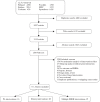For whom and under what circumstances do school-based energy balance behavior interventions work? Systematic review on moderators
- PMID: 21651421
- PMCID: PMC3190836
- DOI: 10.3109/17477166.2011.566440
For whom and under what circumstances do school-based energy balance behavior interventions work? Systematic review on moderators
Abstract
The aim of this review was to systematically review the results and quality of studies investigating the moderators of school-based interventions aimed at energy balance-related behaviors. We systematically searched the electronic databases of Pubmed, EMBASE, Cochrane, PsycInfo, ERIC and Sportdiscus. In total 61 articles were included. Gender, ethnicity, age, baseline values of outcomes, initial weight status and socioeconomic status were the most frequently studied potential moderators. The moderator with the most convincing evidence was gender. School-based interventions appear to work better for girls than for boys. Due to the inconsistent results, many studies reporting non-significant moderating effects, and the moderate methodological quality of most studies, no further consistent results were found. Consequently, there is lack of insight into what interventions work for whom. Future studies should apply stronger methodology to test moderating effects of important potential target group segmentations.
Figures
Similar articles
-
Strategies for enhancing the implementation of school-based policies or practices targeting risk factors for chronic disease.Cochrane Database Syst Rev. 2017 Nov 29;11(11):CD011677. doi: 10.1002/14651858.CD011677.pub2. Cochrane Database Syst Rev. 2017. Update in: Cochrane Database Syst Rev. 2022 Aug 29;8:CD011677. doi: 10.1002/14651858.CD011677.pub3. PMID: 29185627 Free PMC article. Updated.
-
Dietary interventions for recurrent abdominal pain in childhood.Cochrane Database Syst Rev. 2017 Mar 23;3(3):CD010972. doi: 10.1002/14651858.CD010972.pub2. Cochrane Database Syst Rev. 2017. PMID: 28334433 Free PMC article.
-
Interventions for promoting habitual exercise in people living with and beyond cancer.Cochrane Database Syst Rev. 2018 Sep 19;9(9):CD010192. doi: 10.1002/14651858.CD010192.pub3. Cochrane Database Syst Rev. 2018. PMID: 30229557 Free PMC article.
-
Systemic pharmacological treatments for chronic plaque psoriasis: a network meta-analysis.Cochrane Database Syst Rev. 2021 Apr 19;4(4):CD011535. doi: 10.1002/14651858.CD011535.pub4. Cochrane Database Syst Rev. 2021. Update in: Cochrane Database Syst Rev. 2022 May 23;5:CD011535. doi: 10.1002/14651858.CD011535.pub5. PMID: 33871055 Free PMC article. Updated.
-
What works in school-based energy balance behaviour interventions and what does not? A systematic review of mediating mechanisms.Int J Obes (Lond). 2011 Oct;35(10):1251-65. doi: 10.1038/ijo.2011.68. Epub 2011 Apr 12. Int J Obes (Lond). 2011. PMID: 21487398 Free PMC article.
Cited by
-
Changes in adolescents' and parents' intakes of sugar-sweetened beverages, fruit and vegetables after 20 months: results from the HEIA study - a comprehensive, multi-component school-based randomized trial.Food Nutr Res. 2015 Mar 20;59:25932. doi: 10.3402/fnr.v59.25932. eCollection 2015. Food Nutr Res. 2015. PMID: 25797051 Free PMC article.
-
Associations between the School Environment and Physical Activity Pattern during School Time in Swedish Adolescents.Int J Environ Res Public Health. 2021 Sep 29;18(19):10239. doi: 10.3390/ijerph181910239. Int J Environ Res Public Health. 2021. PMID: 34639539 Free PMC article.
-
Predictors of child weight loss and maintenance among family-based treatment completers.J Consult Clin Psychol. 2014 Dec;82(6):1140-1150. doi: 10.1037/a0037169. Epub 2014 Jun 16. J Consult Clin Psychol. 2014. PMID: 24932567 Free PMC article. Clinical Trial.
-
The Effectiveness of School-Based Interventions on Obesity-Related Behaviours in Primary School Children: A Systematic Review and Meta-Analysis of Randomised Controlled Trials.Children (Basel). 2021 Jun 8;8(6):489. doi: 10.3390/children8060489. Children (Basel). 2021. PMID: 34201145 Free PMC article. Review.
-
Effectiveness of the Let's Move It multi-level vocational school-based intervention on physical activity and sedentary behavior: a cluster randomized trial.Ann Behav Med. 2025 Jan 4;59(1):kaaf023. doi: 10.1093/abm/kaaf023. Ann Behav Med. 2025. PMID: 40423552 Free PMC article. Clinical Trial.
References
-
- Flynn MTA, McNeil DA, et al. Reducing obesity and related chronic disease risk in children and youth: a synthesis of evidence with ‘best practice’ recommendations. Obes Rev. 2006;7(Suppl. 1):7–66. - PubMed
-
- Wang Y, Beydoun MA. The obesity epidemic in the United States-gender, age, socioeconomic, racial/ethnic, and geographic characteristics: a systematic review and metaregression analysis. Epidemiol Rev. 2007;29:6–28. - PubMed
-
- Kremers SPJ, Visscher TLS, Seidell JC, van Mechelen W, Brug J. Cognitive determinants of energy balance-related behaviours: measurement issues. Sports Med. 2005;35(11):923–33. - PubMed
-
- Brown T, Summerbell C. Systematic review of school-based interventions that focus on changing dietary intake and physical activity levels to prevent childhood obesity: an update to the obesity guidance produced by the National Institute for Health and Clinical Excellence. Obes Rev. 2009;10:110–41. - PubMed
Publication types
MeSH terms
LinkOut - more resources
Full Text Sources
Medical

